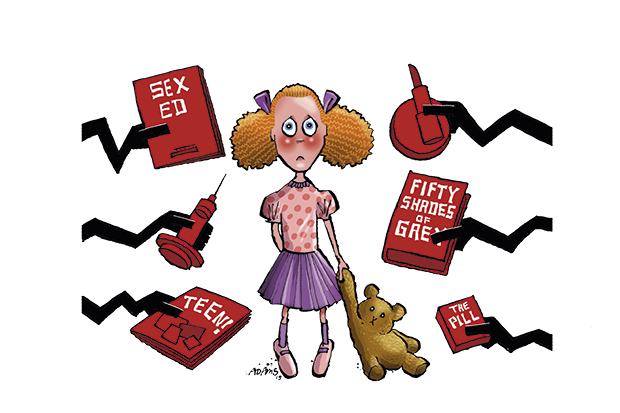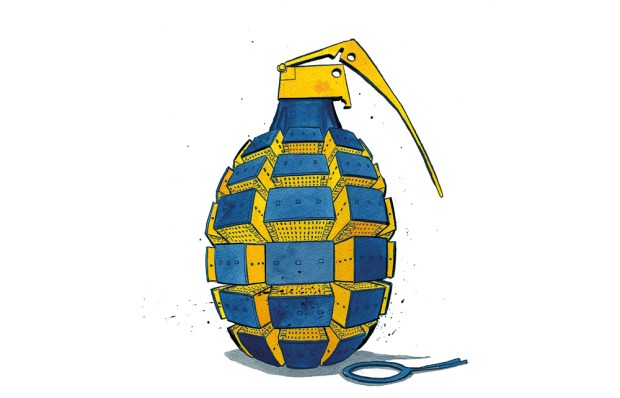Listen
In all the sound and fury about historic sex crimes against children, one crucial factor has been generally ignored. Last week, a review of the agencies dealing with the phenomenon of ‘grooming gangs’ in England said that more than 370 young girls in Oxfordshire had fallen victim to them over the past 15 years, and called for an urgent national debate into these ‘indescribably awful’ sex crimes. But the most shocking and overlooked aspect of the review was that, in Oxford, police and care workers dismissed evidence that girls as young as 11, 12 or 13 were being groomed for sex and repeatedly subjected to brutal sex crimes, intimidation and threats of violence, on the grounds that these were ‘very difficult girls making bad choices’.
Bad choices? For heaven’s sake, these were children! Yet men in their thirties targeting girls as young as 13 were described by police and caring agencies as these children’s ‘boyfriends’.
‘Scores of these professionals used language which appeared at least in part to blame these child victims and view them as adults,’ said the review. So how could such professionals not see them as either children or victims?
This pattern has been repeating itself. From Rotherham to Jimmy Savile and other child sex scandals, police and other agencies dismissed complaints by such girls on the grounds that they were ‘little slags’. These agencies were writing off an entire class of people as low-lifes, whose wretched condition was only to be expected from their debauched behaviour. That in itself was awful.
But the Savile scandal exposed something deeper and more sinister: that countless people connived at what they knew he was doing to these girls, even though some were very young teenagers or younger. That was because his victims were not seen as either children or victims. They were instead looked upon indulgently and amusedly as little ravers, part of ‘youth culture’, merely daft girls flinging themselves at such celebrities. That was because this was the post-Pill era, when sex was uncoupled from marriage and babies and was redefined as a recreational sport. ‘Have fun, but do it safely’ was the message. A bit like skiing.
Even those charged with children’s protection have not regarded premature sexual activity as a problem. Children’s homes have regularly shrugged aside the fact that young girls in their care are too often ‘on the game’ outside their walls. You’d hardly think that we have an age of consent.
In her report on Rotherham council’s failure to deal with the sex grooming gangs which abused at least 1,400 children, Louise Casey, the government’s troubled families czar, identified a culture which treated pregnancies, miscarriages and terminations in children under 16 as normal. Accordingly, she felt obliged to set out in her report the terms of the law prohibiting sexual activity with anyone under that age.
Casey was whistling in the wind. In myriad ways, our society tacitly condones and even encourages the sexualisation of underage children, right up to government level.
As the Oxford review noted: ‘A child may be judged mature enough to get contraceptives to have sex with an adult at an age when they are deemed in law unable to give consent to the sex itself. It is no wonder there was confusion and a lack of confidence in taking action.’ This is as devastating as it is obvious. So devastating, in fact, that the response to this crucial observation has so far been silence.
Dishing out contraceptives to children is deemed essential by all governments. It’s obvious isn’t it (goes the thinking) that, well, children will inevitably get up to stuff? And so society must accept that they’ll be having sex at 12, 11, ten, whatever.
All you can do is try to prevent bad outcomes that have an impact on the rest of us. That means babies. So, of course, you dish out condoms to young teenagers. Of course, you offer abortion services to children as young as 11 without informing their parents. And, of course, you give them sex education, telling even primary school children about oral sex and prostitution.
So the idea that children having sex is always a form of child abuse is dismissed. The only people who could possibly object are by definition religious nuts and reactionaries, right?
Well, not so fast. Last November, the Family Education Trust, which campaigns for traditional values, complained to a committee of MPs about an advice manual for professionals on sex and relationships education, which had been welcomed by the Department for Education. Its concerns centred on a ‘Traffic Light Tool’, published by the Brook sexual health charity, which sets out green, amber and red behaviour for children of different ages.
Brook promptly hit the roof. The Traffic Light Tool, it said, had been developed by experts and ‘does not condone or encourage particular behaviours’.
But it does assign ‘green’ status to sexual activity among 13- to 15-year-olds, which is against the law, and some of the behaviour that Brook thinks is age-appropriate under its ‘traffic light’ rubric is deeply questionable.
For example, among nine- to 13-year-olds, ‘use of sexual language, including swear and slang words’ reflects ‘safe and healthy sexual development’. If your nine-year-old was mouthing sexual obscenities, would you feel satisfied that your child was developing in a ‘safe and healthy’ way?
Viewing pornographic material in this age group, moreover, gets an amber light as being only of ‘potential concern’. Surely there should be nothing remotely ‘potential’ about the concern that should be felt if a nine-year-old was looking at porn?
But when children are between 13 and 17 years old, Brook gives their interest in pornography a ‘safe and healthy’ green light, along with ‘consenting oral and/or penetrative sex with others of the same or opposite gender’ and of similar age and development. Accessing violent pornography, or making and sending naked or sexually provocative images of themselves or others, or joining adults-only social networking sites by giving false personal information, are considered to be only of ‘potential’ concern.
Just how does all that square with Brook’s claim that it ‘does not condone or encourage particular behaviours’? Is it not, in fact, encouraging professionals working with children to condone grossly dangerous and highly sexualised behaviour among fairly young children — and with the backing of the Department for Education?
The fact that such material is justified in this way and enjoys official approval shows that our society is no longer able even to acknowledge how far it has sexualised its children. Sex has become a massive commercial weapon aimed at ever younger ages, targeting the very young with sexually explicit pop lyrics, magazine articles, cosmetics and tarty clothes.
In 2002, a BBC documentary looked at children at a Somerset primary school and what made them popular. An 11-year-old boy wanted to go out with girls who were ‘tarty and daring’; he thought it was ‘sad’ when they wanted to take it ‘one step at a time’. One little girl was taunted because she didn’t want to ‘snog’ until she was 12.
Their parents were egging them on, telling their children that such behaviour was ‘cool’. These parents saw their children as adults. One mother said of her daughter: ‘She’s very mature. She’s 11 going on 27.’ Teachers were also going along with it, discussing who was ‘in love’ with whom in class.
For many children, the age of innocence has disappeared and with it the understanding that parents should protect that innocence. Last week, a secondary school excluded an 11-year-old pupil from its World Book Day celebrations after he turned up dressed as the sadomasochistic character Christian Grey from the erotic novel Fifty Shades of Grey. His costume included cable ties and an eye mask. His mother, a primary school teacher, thought that the outfit was funny. The idea that there was anything inappropriate in dressing him up as a sadomasochist was baffling to her.
In 1885, in response to child prostitution scandals, the age of consent was raised from 13 to 16. The motive behind this progressive reform was to protect children from sexual activity which was deemed grossly inappropriate to childhood. We no longer want to protect children from this. We have gone backwards to a less civilised age.
When we desacralised and casualised sex, didn’t we realise that our children would be harmed? Mass family breakdown has left so many children with no model in their heads of what love is and the place of sex within that. They are prey to a culture that has instead sentimentalised love and evacuated both it and sex of meaning.
So girls of 11 or 12 think they have to have sex with their ‘boyfriends’ to show that they love them, and this is condoned by adults who dish out the condoms and abortions. Then they’re called ‘slags’ by an adult world which claims to be horrified by child sexual abuse.
But this is a society that has institutionalised such abuse. The state itself grooms children for sex. Obsessed by paedophilia, this has become a kind of paedophile society.
The boundary between childhood and adult life has become dangerously blurred by moral confusion, selfishness and hypocrisy. Yet we do have a way of demarcating that boundary. It’s called the age of consent. Let’s start using it again.
Got something to add? Join the discussion and comment below.
Get 10 issues for just $10
Subscribe to The Spectator Australia today for the next 10 magazine issues, plus full online access, for just $10.
You might disagree with half of it, but you’ll enjoy reading all of it. Try your first month for free, then just $2 a week for the remainder of your first year.














Comments
Don't miss out
Join the conversation with other Spectator Australia readers. Subscribe to leave a comment.
SUBSCRIBEAlready a subscriber? Log in